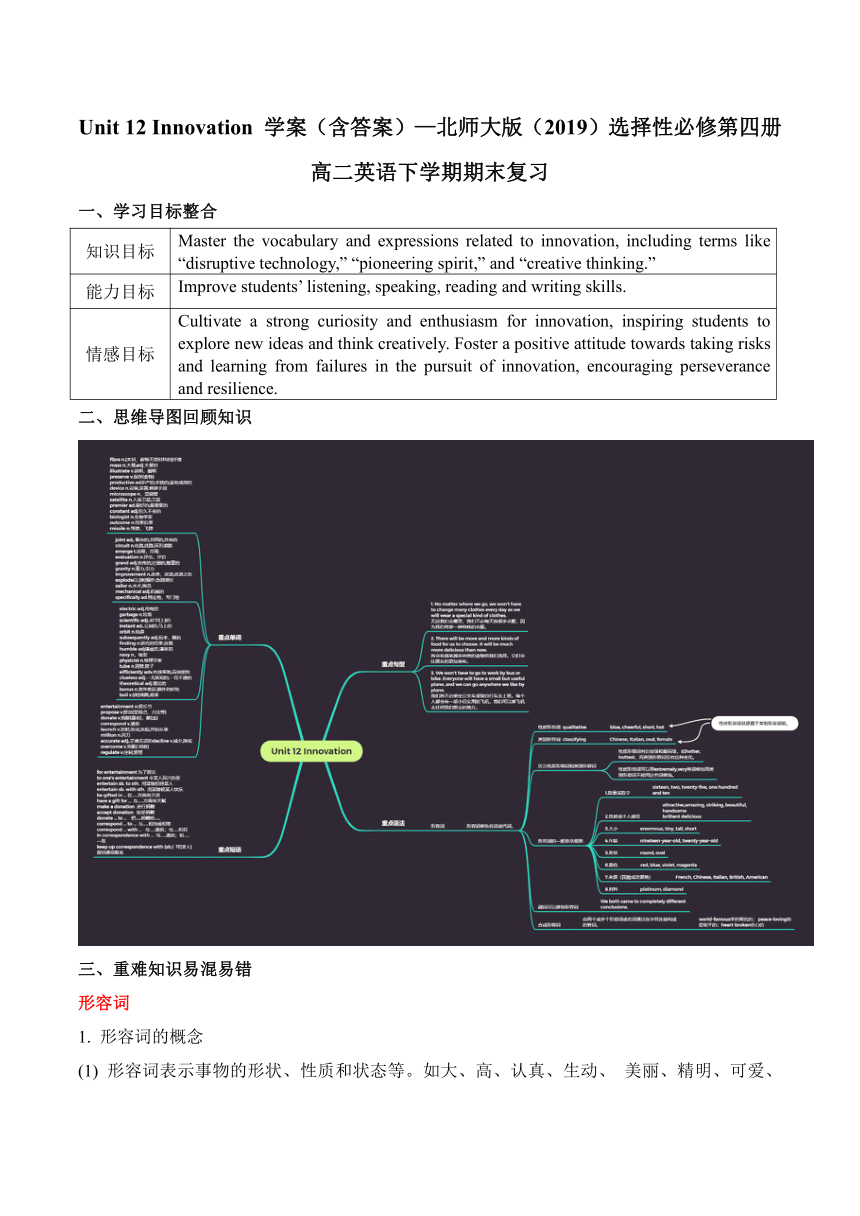
Unit 12 Innovation 学案(含答案)—北师大版(2019)选择性必修第四册高二英语下学期期末复习 一、学习目标整合 知识目标 Master the vocabulary and expressions related to innovation, including terms like “disruptive technology,” “pioneering spirit,” and “creative thinking.” 能力目标 Improve students’ listening, speaking, reading and writing skills. 情感目标 Cultivate a strong curiosity and enthusiasm for innovation, inspiring students to explore new ideas and think creatively. Foster a positive attitude towards taking risks and learning from failures in the pursuit of innovation, encouraging perseverance and resilience. 二、思维导图回顾知识 三、重难知识易混易错 形容词 1. 形容词的概念 (1) 形容词表示事物的形状、性质和状态等。如大、高、认真、生动、 美丽、精明、可爱、冰凉、初级、高级、简单、复杂等。 (2) 形容词是一种主要用来描写或修饰名词或代词的词类,可以用来表示人或事物的性质、状态、特征或属性,常用作定语,也可作表语、补语或状语。 (3) 形容词通常置于其修饰的名词之前,并且多数形容词有比较等级 2. 形容词的句法功能 (1) 作定语(前置定语或后置定语) She lives in a cozy cottage in the countryside. 她住在乡村一间舒适的小屋里。(cozy作cottage的前置定语) He is one of the few people awake at this late hour. 他是这么晚还没睡的少数人之一。(awake作people的后置定语) Is there anything interesting in today's newspaper 今天的报纸上有什么有趣的内容吗?(形容词修饰复合不定代词,作后置定语) This is the only solution possible for the problem. 这是该问题唯一可能的解决方案。(以-able或-ble结尾的形容词可作前面有形容词最高级或the only等修饰的名词的后置定语) He recommended a movie suitable for all ages. 他推荐了一部适合各年龄段的电影。(形容词短语作后置定语) (2) 作表语 The new museum exhibit is fascinating. 博物馆的新展品很吸引人。 She felt nervous before the important job interview. 重要的工作面试前,她感到紧张。 (3) 作宾语补足语 They elected him president of the student union. 他们选他当学生会主席。 I find the new policy confusing and difficult to understand. 我觉得新政策令人困惑,难以理解。 3. 合成形容词的构成 (1) 副词+分词,如:well-known 著名的 (2) 名词+过去分词,如:hand-made 手工的 (3) 名词+现在分词,如:peace-loving 爱好和平的 (4) 名词+形容词,如:state-owned 国有的 (5) 数词+名词,如:ten-minute 十分钟的 (6) 数词+名词-ed,如:one-eyed 一只眼的 (7) 数词+名词+形容词,如:two-month-old 两个月的 (8) 形容词+过去分词,如:new-born 新生的 (9) 形容词+名词-ed,如:short-sighted 目光短浅的 (10) 形容词+现在分词,如:old-looking 看起来很旧的 (11) 形容词+形容词,如:dark-blue 深蓝色的 4. 形容词比较级和最高级的构成规则 (1) 一般加-er或-est quiet—quieter—quietest (2) 以字母e结尾的词只加-r或-st large—larger—largest (3) 以一个辅音字母结尾的重读闭音节词,双写这一辅音字母后再加-er或-est thin—thinner—thinnest (4) 以“辅音字母+-y”结尾的单词,将y变为i,再加-er或-est happy—happier—happiest (5) 多音节词和部分双音节词,在其前加more或most intelligent—more intelligent—most intelligent (6) 不规则变化单独记忆 good—better—best bad—worse—worst far—farther/further—farthest/furthest 练习: ... ...
~~ 您好,已阅读到文档的结尾了 ~~

